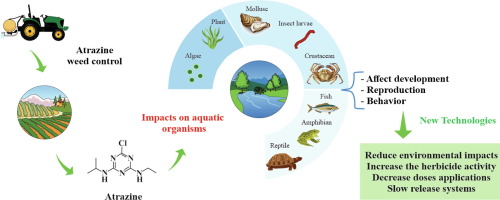当前位置:
X-MOL 学术
›
Sci. Total Environ.
›
论文详情
Our official English website, www.x-mol.net, welcomes your feedback! (Note: you will need to create a separate account there.)
An overview of the potential impacts of atrazine in aquatic environments: Perspectives for tailored solutions based on nanotechnology.
Science of the Total Environment ( IF 8.2 ) Pub Date : 2019-10-31 , DOI: 10.1016/j.scitotenv.2019.134868 Felícia Pereira de Albuquerque 1 , Jhones Luiz de Oliveira 1 , Viviane Moschini-Carlos 1 , Leonardo Fernandes Fraceto 1
Science of the Total Environment ( IF 8.2 ) Pub Date : 2019-10-31 , DOI: 10.1016/j.scitotenv.2019.134868 Felícia Pereira de Albuquerque 1 , Jhones Luiz de Oliveira 1 , Viviane Moschini-Carlos 1 , Leonardo Fernandes Fraceto 1
Affiliation

|
Atrazine is a pre- and post-emergence herbicide used to control weeds in many crops. It was introduced in the late 1950s, but its use has been controversial because of its high potential for environmental contamination. In agriculture, the implementation of sustainable practices can help in reducing the adverse effects atrazine. This review addresses aspects related to the impacts of atrazine in the environment, with focus on its effects on aquatic species, as well as the potential use of nanoencapsulation to decrease the impacts of atrazine. The application of atrazine leads to its dispersal beyond the immediate area, with possible contamination of soils, sediments, plantations, pastures, public supply reservoirs, groundwater, streams, lakes, rivers, seas, and even glaciers. In aquatic ecosystems, atrazine can alter the biota, consequently interfering in the food chains of many species, including benthic organisms. Nanoformulations loaded with atrazine have been developed as a way to reduce the adverse impacts of this herbicide in aquatic and terrestrial ecosystems. Ecotoxicological bioassays have shown that this nanoformulations can improve the targeted delivery of the active ingredient, resulting in decreased dosages to obtain the same effects as conventional formulations. However, more detailed analyses of the ecotoxicological potential of atrazine-based nanoherbicides need to be performed with representative species of different ecosystems.
中文翻译:

阿特拉津在水生环境中的潜在影响概述:基于纳米技术的量身定制解决方案的观点。
阿特拉津是一种出苗前和出苗后的除草剂,用于控制许多农作物中的杂草。它是在1950年代后期推出的,但由于其潜在的环境污染潜力而引起争议。在农业中,实施可持续做法可以帮助减少阿特拉津的不利影响。这篇综述探讨了与r去津对环境的影响有关的方面,重点是对r去津对水生物种的影响,以及纳米封装技术在减少对r去津的影响方面的潜在用途。阿特拉津的应用导致其扩散到附近地区,可能污染土壤,沉积物,人工林,牧场,公共供应水库,地下水,溪流,湖泊,河流,海洋,甚至冰川。在水生生态系统中,at去津可以改变生物群,因此会干扰包括底栖生物在内的许多物种的食物链。已经开发了装载有r去津的纳米制剂,以减少这种除草剂对水生和陆地生态系统的不利影响。生态毒理学生物测定法表明,这种纳米制剂可以改善活性成分的靶向递送,从而降低剂量以获得与常规制剂相同的效果。但是,需要对具有不同生态系统的代表性物种进行基于at去津的纳米除草剂的生态毒理学潜力的更详细分析。生态毒理学生物测定法表明,这种纳米制剂可以改善活性成分的靶向递送,从而降低剂量以获得与常规制剂相同的效果。但是,需要对具有不同生态系统的代表性物种进行基于at去津的纳米除草剂的生态毒理学潜力的更详细分析。生态毒理学生物测定法表明,这种纳米制剂可以改善活性成分的靶向递送,从而降低剂量以获得与常规制剂相同的效果。但是,需要对具有不同生态系统的代表性物种进行基于at去津的纳米除草剂的生态毒理学潜力的更详细分析。
更新日期:2019-11-01
中文翻译:

阿特拉津在水生环境中的潜在影响概述:基于纳米技术的量身定制解决方案的观点。
阿特拉津是一种出苗前和出苗后的除草剂,用于控制许多农作物中的杂草。它是在1950年代后期推出的,但由于其潜在的环境污染潜力而引起争议。在农业中,实施可持续做法可以帮助减少阿特拉津的不利影响。这篇综述探讨了与r去津对环境的影响有关的方面,重点是对r去津对水生物种的影响,以及纳米封装技术在减少对r去津的影响方面的潜在用途。阿特拉津的应用导致其扩散到附近地区,可能污染土壤,沉积物,人工林,牧场,公共供应水库,地下水,溪流,湖泊,河流,海洋,甚至冰川。在水生生态系统中,at去津可以改变生物群,因此会干扰包括底栖生物在内的许多物种的食物链。已经开发了装载有r去津的纳米制剂,以减少这种除草剂对水生和陆地生态系统的不利影响。生态毒理学生物测定法表明,这种纳米制剂可以改善活性成分的靶向递送,从而降低剂量以获得与常规制剂相同的效果。但是,需要对具有不同生态系统的代表性物种进行基于at去津的纳米除草剂的生态毒理学潜力的更详细分析。生态毒理学生物测定法表明,这种纳米制剂可以改善活性成分的靶向递送,从而降低剂量以获得与常规制剂相同的效果。但是,需要对具有不同生态系统的代表性物种进行基于at去津的纳米除草剂的生态毒理学潜力的更详细分析。生态毒理学生物测定法表明,这种纳米制剂可以改善活性成分的靶向递送,从而降低剂量以获得与常规制剂相同的效果。但是,需要对具有不同生态系统的代表性物种进行基于at去津的纳米除草剂的生态毒理学潜力的更详细分析。











































 京公网安备 11010802027423号
京公网安备 11010802027423号